
A beehive is an enclosed structure in which some honey bee species of the subgenus Apis live and raise their young. Though the word beehive is used to describe the nest of any bee colony, scientific and professional literature distinguishes nest from hive. Nest is used to discuss colonies that house themselves in natural or artificial cavities or are hanging and exposed. The term hive is used to describe an artificial/man-made structure to house a honey bee nest. Several species of Apis live in colonies. But for honey production, the western honey bee and the eastern honey bee are the main species kept in hives.

A beekeeper is a person who keeps honey bees, a profession known as beekeeping.
Beekeeping is the maintenance of bee colonies, commonly in man-made beehives. Honey bees in the genus Apis are the most commonly kept species but other honey producing bees such as Melipona stingless bees are also kept. Beekeepers keep bees to collect honey and other products of the hive: beeswax, propolis, bee pollen, and royal jelly. Other sources of beekeeping income include pollination of crops, raising queens, and production of package bees for sale. Bee hives are kept in an apiary or "bee yard".
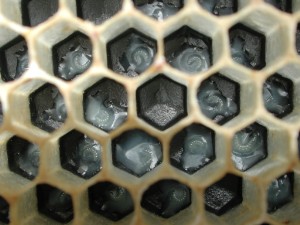
In beekeeping, bee brood or brood refers to the eggs, larvae and pupae of honeybees. The brood of Western honey bees develops within a bee hive. In man-made, removable frame hives, such as Langstroth hives, each frame which is mainly occupied by brood is called a brood frame. Brood frames usually have some pollen and nectar or honey in the upper corners of the frame. The rest of the brood frame cells may be empty or occupied by brood in various developmental stages. During the brood raising season, the bees may reuse the cells from which brood has emerged for additional brood or convert it to honey or pollen storage. Bees show remarkable flexibility in adapting cells to a use best suited for the hive's survival.
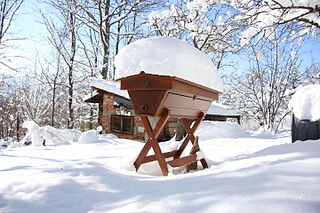
A top-bar hive is a single-story frameless beehive in which the comb hangs from removable bars. The bars form a continuous roof over the comb, whereas the frames in most current hives allow space for bees to move up or down between boxes. Hives that have frames or that use honey chambers in summer but which use management principles similar to those of regular top-bar hives are sometimes also referred to as top-bar hives. Top-bar hives are rectangular in shape and are typically more than twice as wide as multi-story framed hives commonly found in English-speaking countries. Top-bar hives usually include one box only, and allow for beekeeping methods that interfere very little with the colony. While conventional advice often recommends inspecting each colony each week during the warmer months, heavy work when full supers have to be lifted, some beekeepers fully inspect top-bar hives only once a year, and only one comb needs to be lifted at a time.
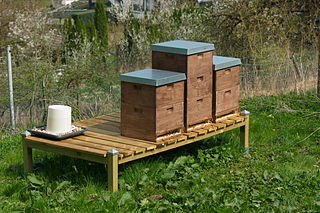
In beekeeping, a Langstroth hive is any vertically modular beehive that has the key features of vertically hung frames, a bottom board with entrance for the bees, boxes containing frames for brood and honey and an inner cover and top cap to provide weather protection. In a Langstroth hive, the bees build honeycomb into frames, which can be moved with ease. The frames are designed to prevent bees from attaching honeycombs where they would either connect adjacent frames, or connect frames to the walls of the hive. The movable frames allow the beekeeper to manage the bees in a way which was formerly impossible.

A hive frame or honey frame is a structural element in a beehive that holds the honeycomb or brood comb within the hive enclosure or box. The hive frame is a key part of the modern movable-comb hive. It can be removed in order to inspect the bees for disease or to extract the excess honey.

A honey extractor is a mechanical device used in the extraction of honey from honeycombs. A honey extractor extracts the honey from the honey comb without destroying the comb. Extractors work by centrifugal force. A drum or container holds a frame basket which spins, flinging the honey out. With this method the wax comb stays intact within the frame and can be reused by the bees.

Lorenzo Lorraine Langstroth was an American apiarist, clergyman, and teacher, and considered to be the father of American beekeeping. He recognized the concept of bee-space, a minimum distance that bees avoid sealing up. Although not his own discovery, the use of this principle allowed for the use of frames that the bees leave separate and this allowed the use of rectangular frames within the design of what is now called the Langstroth hive.

Charles Dadant was a French-American beekeeper. Along with Petro Prokopovych, Dadant is considered one of the founding fathers of modern beekeeping.

Moses Quinby was an American beekeeper from the State of New York. He is remembered as the father of practical beekeeping and the father of commercial beekeeping in America. He is best known as the inventor of the bee smoker with bellows. He was the author of numerous articles and several books on beekeeping.
Charles Butler, sometimes called the Father of English Beekeeping, was a logician, grammarian, author, priest, and an influential beekeeper. He was also an early proponent of English spelling reform. He observed that bees produce wax combs from scales of wax produced in their own bodies; and he was among the first to assert that drones are male and the queen female, though he believed worker bees lay eggs.
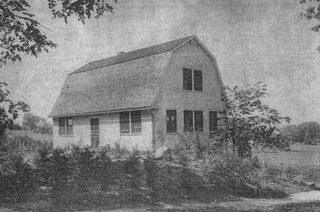
The Apiary Laboratory, more often referred to as the Apiary, is a research laboratory at the University of Massachusetts Amherst. Originally built for the study of honey bees and apiculture, today it is primarily used to study native pollinator species and the chemicals and pathogens impacting their populations. This academic building is unique in that it is credited as being the first in the United States to be erected exclusively for the teaching of beekeeping.

Urban beekeeping is the practice of keeping bee colonies (hives) in towns and cities. It is also referred to as hobby beekeeping or backyard beekeeping. Bees from city apiaries are said to be "healthier and more productive than their country cousins". As pollinators, bees also provide environmental and economic benefits to cities. They are essential in the growth of crops and flowers.

Thomas White Woodbury was an English journalist and beekeeper, devoting himself entirely to beekeeping from 1850 onwards after the death of his son. He was responsible for introducing Ligurian or Italian bees to Britain in 1859.
In 1859 Woodbury imported a yellow Ligurian queen from Mr Hermann in Switzerland. She arrived by train on 3 August in a rough deal box with about a thousand worker bees. Woodbury had prepared an 8-bar hive, including four frames of honey and pollen plus one empty comb, and he gently shook the newcomers into this. Then he took a skep of local black bees weighing 34.5 pounds and shook them out in clusters on four cloths spread out on the grass; helped by his friend Mr Fox. He found and took out the queen, before placing the hive with Ligurian queen and bees over the shaken bees. Alas they fought, and in the morning there were many dead bees, but he hoped for the best. By 17 August, great loads of pollen were going in, and he knew that the first queen from outside Britain had been introduced. When he wrote about this in the 'Cottage Gardener' he had letters from all over the country asking for stocks from this queen for next year, so at once he telegraphed for two more queens and they arrived on 27 August having been four days on the way. Although most of the bees were dead, each package had their queen still living, and each queen was successfully introduced to a colony. Ron Brown Great Masters of Beekeeping
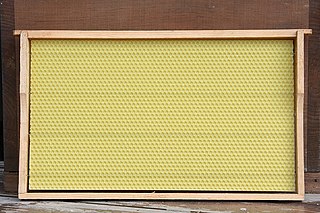
Wax foundation or honeycomb base is a plate made of wax forming the base of one honeycomb. It is used in beekeeping to give the bees a foundation on which they can build the honeycomb. Wax foundation is considered one of the most important inventions in modern beekeeping.

Beekeeping in Australia is a commercial industry with around 25,000 registered beekeepers owning over 670,000 hives in 2018. Most are found in the eastern states of Queensland, New South Wales, Victoria and Tasmania as well as the south-west of Western Australia.
Honey bee starvation is a problem for bees and beekeepers. Starvation may be caused by unfavorable weather, disease, long distance transportation or depleting food reserve. Over-harvesting of honey is the foremost cause for scarcity as bees are not left with enough of a honey store, though weather, disease, and disturbance can also cause problems. Backyard beekeepers face more colony losses in the winter than in the summer, but for commercial beekeepers there is not much variation in loss by season. Starvation may be avoided by effective monitoring of hives and disease prevention measures. Starvation can amplify the toxic effect of pesticides bees are exposed to.

Flow Hive is a beehive brand with a unique honey frame designed to allow honey extraction without needing to open the beehive. During extraction, visibly bees are disturbed less than during other methods.

Franz Hruschka, Franz von Hruschka, Francesco De Hruschka, František Hruška was an Austrian/Italian of Czech origin officer and beekeeper known as the inventor of the honey extractor, an invention he presented in 1865 at the Brno Beekeeper Conference.





















